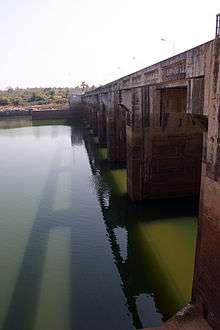Pak Mun Dam
| Pak Mun Dam | |
|---|---|
 Main wall of the Pak Mun Dam | |
 Location of Pak Mun Dam in Thailand | |
| Country | Thailand |
| Location | Ubon Ratchathani Province |
| Coordinates | 15°16′55″N 105°28′6″E / 15.28194°N 105.46833°ECoordinates: 15°16′55″N 105°28′6″E / 15.28194°N 105.46833°E |
| Opening date | 1994 |
| Dam and spillways | |
| Impounds | Mun River |
| Height | 17 m (56 ft) |
| Length | 300 m (984 ft) |
| Width (crest) | 7.5 m (25 ft) |
| Reservoir | |
| Creates | Pak Mun Reservoir |
| Power station | |
| Operator(s) | EGAT |
| Turbines | 4[1] |
| Installed capacity | 136 MW |
| Annual generation | 290 GWh |
The Pak Mun Dam (Thai: เขื่อนปากมูล) is a barrage dam and run-of-the-river hydroelectric plant located 5.5 km west of the confluence of the Mun and Mekong Rivers in Ubon Ratchathani Province, Thailand. It was constructed by the Electricity Generating Authority of Thailand (EGAT) with support from the World Bank at a total cost of US$240 million, and completed in 1994.
The project has been criticized for adverse effects on the fisheries of the Mun River, insufficient compensation payments to affected villagers, and failure to produce the projected power output. The immediate impact of the dam was to flood 117 km2 of land and displace families. The original plan estimated the displacement of 262 families. In the end, 912 families were displaced and 780 households lost all or part of their land.[2] In all, around 25,000 villagers claim to have been affected by the dam. Protests have been staged at the dam site and outside Government House in Bangkok. EGAT has paid out US$44.24 million in relocation compensation, plus US$15.8 million for loss of fisheries.[3]
Fisheries
In response to concerns about the dam's likely impact on fisheries on the Mun River, a fish ladder was incorporated into the scheme to allow fish into the Mun River to spawn. However, the ladder appears to have been unsuccessful. A report from the World Commission on Dams found that of 265 fish species previously found in the Mun River, at least 50 had disappeared and numbers of others had declined significantly. The fish catch decreased by 60–80 percent. It is uncertain what proportion of this decrease is attributable to the dam, and what proportion to other factors.
In response to protests, the government opened the dam gates temporarily in June 2001. Subsequently, a study by Ubon Ratchathani University recommended keeping the gates open for a further five years, and a study by Living River Siam recommended decommissioning the dam. Instead, the Thai Cabinet decided to close the gates for eight months each year from November 2002.[4]
Electricity generation
The World Commission on Dams report raised doubts about the amount of power which the dam can produce. It argued that the dam could not reliably produce the anticipated amount of electricity, making it economically nonviable. EGAT responded that such consistent electricity production was unnecessary, and that the dam was a useful source of electricity.
References
- ↑ EGAT: Pak Mun Dam
- ↑ Kiguchi, Yuka (2016-02-22). "Pak Moon dam still a dilemma 25 years on". Bangkok Post. Retrieved 23 February 2016.
- ↑ Open Buildings: Pak Mun Dam
- ↑ International Rivers: Pak Mun Dam
External links
- Tyson R. Roberts (2001). "On The River of no Returns: Thailand's Pak Mun Dam and its Fish Ladder" (PDF). Nat. Hist. Bull. Siam Soc. Thai Science (49): 189–230. Retrieved 16 December 2013.